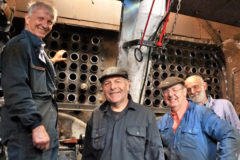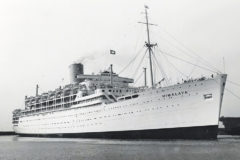Leyland’s new tractor range
Posted by Chris Graham on 24th February 2022
Jonathan Whitlam takes a fascinating and nostalgic look back at the launch of Leyland’s new tractor range in 1972.
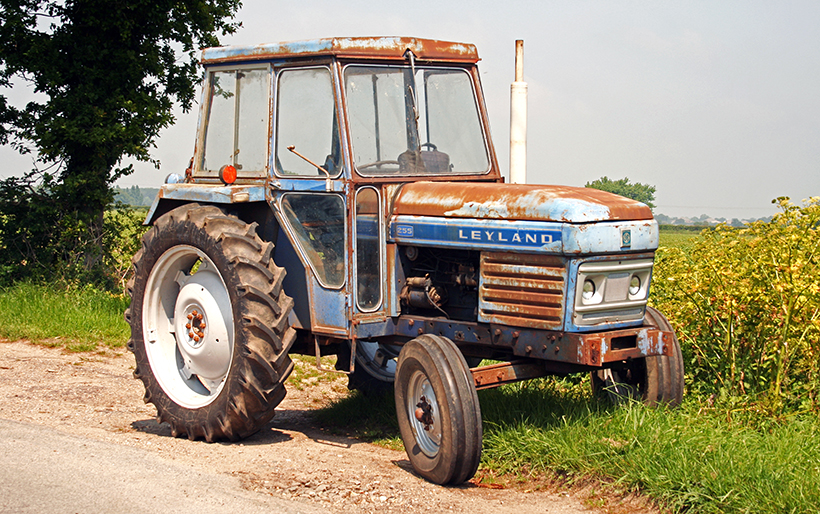
Leyland’s new tractor range: A weathered example of the Leyland 255, the smallest of the new 1972 Leyland range to feature the new 4/98 engine. The safety cab was brought across from the 344 model that the 255 replaced, and was capable of being tipped backwards to gain access to the driveline.
It was half a century ago when British Leyland made its biggest ever launch of new tractor models. In later years a big revamp would occur, but that was pretty tame in comparison with what happened in 1972 – when the company decided to go all out to compete with the big players in the tractor market.
Despite the Leyland name only being placed on tractors three years before, the new models that appeared during 1972 would pave the way for the rest of Leyland tractor production beyond 1980. So, how did it all start?
Leyland’s birth
Back in 1972, Leyland was still a very new name when it came to agricultural tractors. While the Leyland name itself came from Leyland Motors, based in the Lancashire town of Leyland, various mergers during the course of the 1960s led to lots of other British companies being absorbed, until the mega-merger at the end of the decade, which saw British Motor Holdings Ltd. and Leyland join forces as the British Leyland Motor Corporation Ltd., known simply as British Leyland.
British Motor Holdings Ltd., itself the result of a merger, included the Nuffield tractor range that had originally been created in 1948 by Morris. This range, painted orange, had slowly evolved over the years and, in 1967, comprised three new models: the little 4/25 derived from the earlier BMC Mini tractor, the 3/45 which was the only three-cylinder-powered tractor in the range, and the flagship 4/65 model.
Reliability issues and a perceived need to update the ageing Nuffield brand were two of the reasons that these tractors, built in a factory at Bathgate in Scotland shared by the production lines of the Leyland small and medium-sized truck ranges, were phased out in 1969 with a range of three Leyland-branded tractors replacing the old order. Instead of being orange, these new tractors wore a new blue and silver colour scheme.
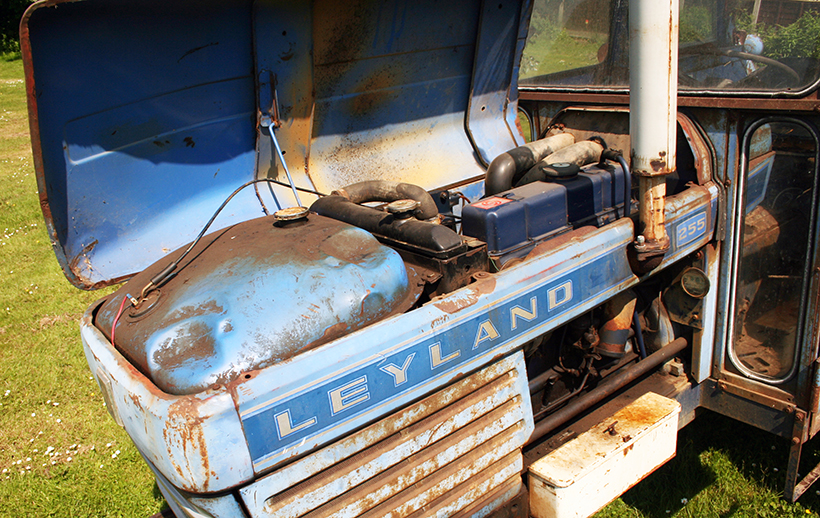
The top cover of the bonnet on the Leyland tractors could be tilted to gain access to the fuel tank, radiator and the 4/98 engine. The two panels below, retained by a spring, could also be removed to get at the battery positioned under the fuel tank at the front.
These first Leyland tractors, with new styling as well as the new colours, included the little 154, basically a re-painted Nuffield 4/25 and the least changed of all the new tractors. The flagship 4/65 model was replaced by the new 70hp 384 and the new 344 was the replacement for the 3/45 and, as this model now featured a new motor, the whole Leyland range was powered by four-cylinder engines.
The reason that the three-cylinder tractor was replaced by the four-cylinder, 55hp 344 was that the BMC engines used were being built at Bathgate, but only in four- and six-cylinder variants. The old three-cylinder engine for the Nuffield 3/45 was built in the Midlands, where the Nuffield tractors had originally been constructed, and so the deletion of the three-cylinder powerplant helped reduce costs incurred by transporting engines around the country.
The new models, particularly the 344 and 384, set design trends that would remain a feature of Leyland tractors for some time. Indeed, the new bonnets with their opening top covers and the two side panels mounted on springs on either side, would remain on all subsequent Leyland tractors and even their Marshall successors.
The Nuffield 10-speed transmission was also retained on the 344 and 384, this being a feature of the last two generations of Nuffield tractors and still considered to be at least equal to what the competition had to offer.
One feature of these first Leyland tractors that would not remain though, was the engine line-up. Leyland took the four-cylinder engine that had originally been designed and built by BMC and improved it considerably, including better balancing to reduce noise and vibration. Ultimately, this was just a stop gap measure, as a new series of Leyland diesel engines was already under development.
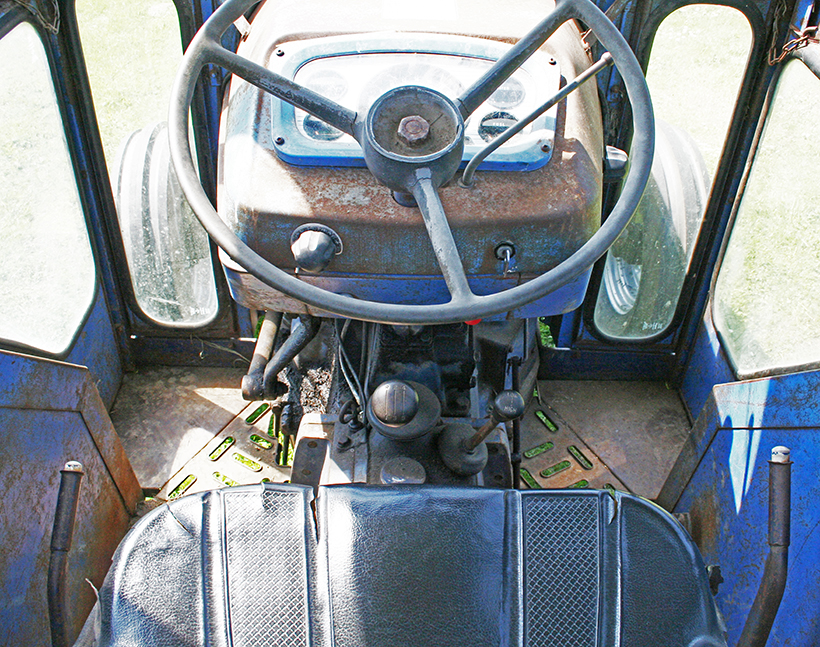
Inside the cab of the 255, supplied to Leyland by Sta-Dri, all of the main controls were within easy reach of the driving seat. The two gear levers were positioned on the central transmission tunnel with five ratios and reverse being selected by the left lever and high and low by the smaller right-hand stick, giving a 10 forward and two reverse transmission.
The first major thing to happen after the launch of the first Leyland tractors in 1969 was the need to develop safety cabs to meet the legislation that came into force during 1970. For the two larger models, Leyland came up with a stylish cab developed in conjunction with Sta-Dri, which then built them for Leyland. These cabs had a large glass area with slim, but strong, pillars and suited the design of the 344 and 384 well. The cabs also had the ability to easily tilt back the top half rearwards to gain access to the driveline for maintenance purposes. The end result was an advanced cab design for 1970.
Then, in 1971, a new model arrived. Farmers had still wanted the option of a three-cylinder tractor, due to the fact that it resulted in a lighter machine, the 344 being almost the same weight as the more powerful 384. Leyland listened and the request was granted with the launch of the new 253 model, powered by a three-cylinder Perkins engine that was already being used to great acclaim in the Massey Ferguson 135 tractor and had originally been used in the earlier 35 model.
Leyland could not justify the cost of putting a three-cylinder engine into production at Bathgate, as its only application would have been for this tractor, and so it decided to buy-in a powerplant instead, even if that meant buying from a competitor; Perkins engines being owned by Massey Ferguson.
As it turned out, the 253 would not last long in its original guise because, in 1972, big changes were on the way!
Middleweights
So far Leyland had produced two types of tractors: the 154, classed as a Lightweight model, and the 253, 344 and 384 – that it called the Middleweight models. By the end of 1972 only the 154 would remain as before and four new Heavyweight models would join the fold.
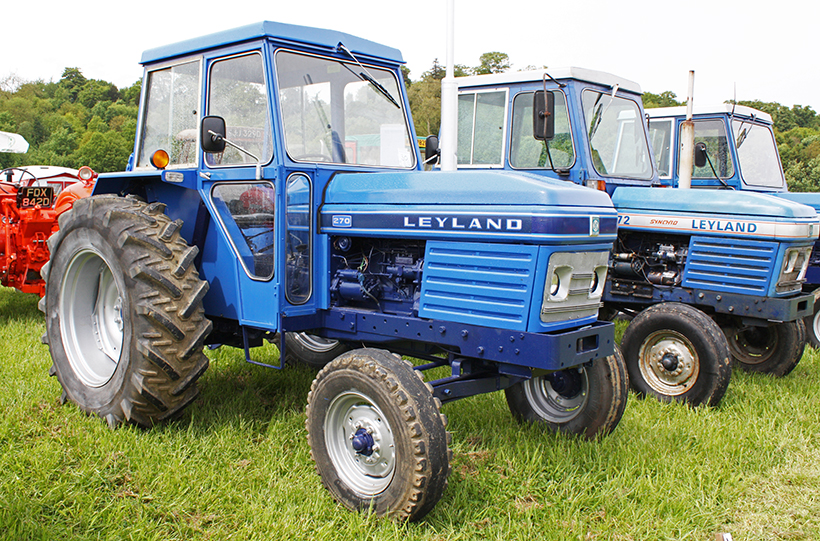
The Leyland 270 was the best seller in the range, with its 70hp being seen as ideal for both medium and heavy tasks – the 4/98 engine proving to be one of the strong points of the model. Note the side rails which the engine and other components sit in, a design first seen on the Nuffield Universal of 1948 and still used by the Leyland designers.
The 253 now became the 245, signifying a change of numbering system that moved away from the cubic engine capacity and now had the number ‘2’ referring to two-wheel drive while the ‘45’ related to the power output. Apart from this change, the 245 was otherwise mostly unchanged from the 253 only launched the previous year.
The 344 was replaced by the new 255, a model which, with 55hp available, was a direct replacement for its predecessor. The 384 was replaced by the 270 which, like the 255, was powered by a new generation of Leyland diesel engine called the 98 Series. In the case of these two models, the exact engine was the 4/98.
This was a much better engine than the old BMC-derived units and produced much less noise and vibration. It was also a much less thirsty powerplant and soon became renowned for its reliability and economy. The same 4/98 engine was used in both new models, with the fuelling being altered to produce the different power requirements.
The 10-speed transmission was retained, as this was still pretty up-to-date given the number of ratios available, and the levers to operate the gearbox were still positioned centrally, in front of the driver’s seat. The same safety cab was also brought across from the earlier models.
The 255, and especially the 270, soon became very successful models for Leyland, selling well in many different countries, and a lot of that success could be put down to the use of the 4/98 engine.
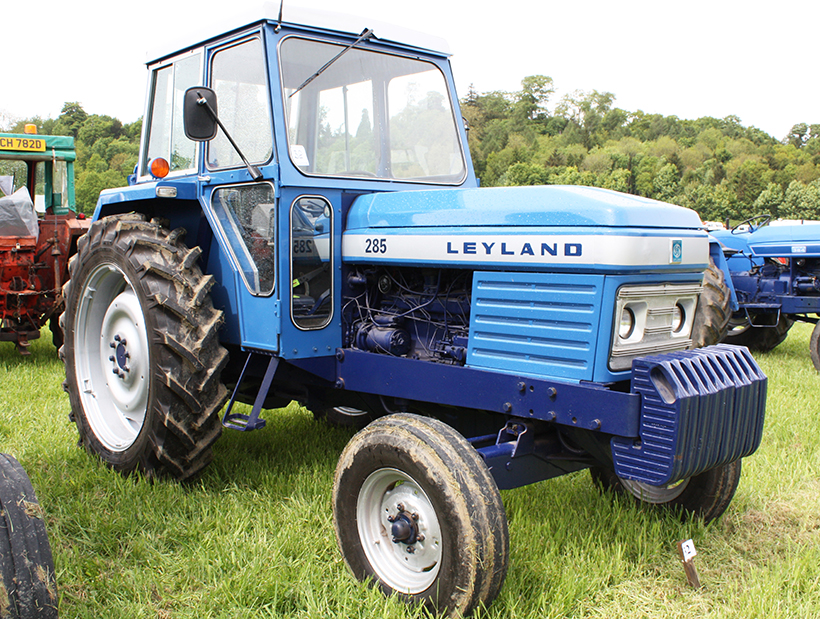
This is a later example of the 285 complete with newer-style bonnet decals. The side rails were beefed up slightly to accommodate the more powerful six-cylinder engines.
Heavyweights
Of course, the 4/98 engine was also developed for truck use and this also saw the development of the 6/98 engine, a six-cylinder variant capable of a higher power output. It was this new engine that was at the heart of the new Leyland heavyweight tractors launched at the Royal Smithfield Show in London at the end of 1972.
As the model numbers signified, the new 285 and 2100 were 85 and 100hp two-wheel drive tractors respectively. Although the bonnet looked longer it was exactly the same as the one used on the four-cylinder models, the extra space needed for the six-cylinder engine being made available by moving the fuel tank from the front to the very back of the tractor. The exhaust silencer was also moved to a rearward position, instead of on the side of the bonnet as on the four-cylinder machines, and was now mounted up the rear cab window pillar – a giving unrivalled forward visibility for this class of tractor.
A flat-floor cab was also made possible by raising the floor level of the cab slightly and the transmission was now controlled by side-mounted gear levers connected to the transmission by rod linkages.
These were large and powerful tractors in 1972, most farmers not even thinking about owning an 85hp machine, let alone a 100hp tractor! Mated to the old 10-speed transmission and with the safety cab fitted, the 285 and 2100 were truly impressive machines.
But Leyland did not stop there. It also offered four-wheel drive versions of the two six-cylinder tractors. Rather than develop its own four-wheel drive system, Leyland turned to County Commercial Cars, based in Fleet, Hampshire, to provide its own four-wheel drive solution for the Leyland six-cylinder tractors.
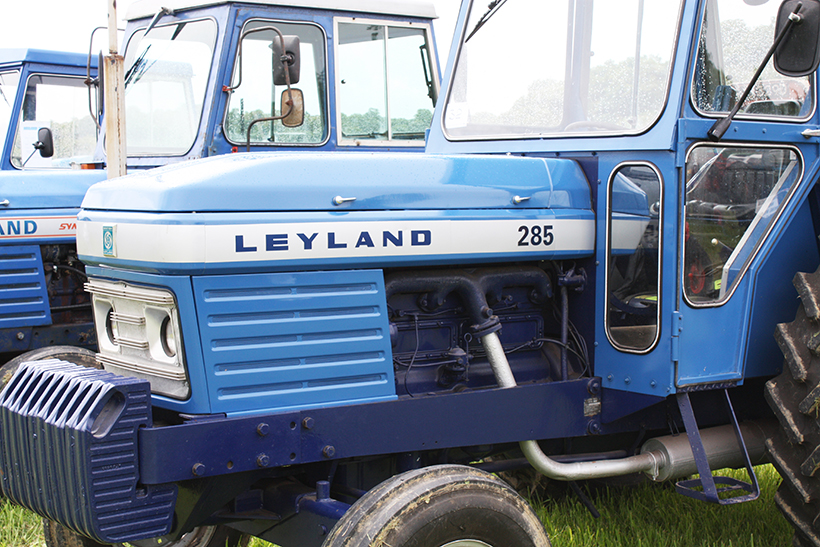
With front fuel tank moved to the rear, the six-cylinder 6/98 engine fitted snugly under the bonnet of the new 285 model, and the exhaust was downswept to pass under the cab and emerge at the rear, giving excellent forward visibility.
County adapted its unique twin-prop design with equal-size wheels to fit the Leyland tractors. This system had first been used on Fordson Super Major skid units and then six-cylinder derivatives. County then went on to produce a whole range of four-wheel drive tractors using the same design and based on later Ford tractors, as well as a small number of International Harvester-based machines.
In the same timespan as the Leyland four-wheel drive tractors were being built, County had just started producing its most powerful tractors so far, based on the American-built Ford 9000 and its successor, the 9600. These were 145hp tractors that actually made the new Leyland machines look rather small in comparison!
The Leyland tractors with the County four-wheel drive system were launched as the 485 and the 4100. Once again, the same transmission and safety cab were used, although the lower front section had to be modified to allow enough clearance for the large front wheels to turn. The County system also gave a low centre of gravity, making the tractors ideal for working on steep ground and the tractor’s differential lock now worked on all four wheels.
These two new tractors were extremely impressive and with their proven County components were seen as of great interest to larger-scale farmers, estates and contractors. The 6/98 engines were just as reliable as the 4/98 units and everything looked set for the whole range to be a great success. Unfortunately, not everything would go according to plan!
Heartache
The 245, 255 and 270 performed well, but the six-cylinder tractors had an Achille’s Heel in the way they were put together with the old 10-speed transmission. Failures soon began to reported from customers as the problems manifested themselves with the connection between the rubber-mounted engine and the transmission itself, the whole assembly becoming misaligned when subjected to the normal stresses and strains of farm work.
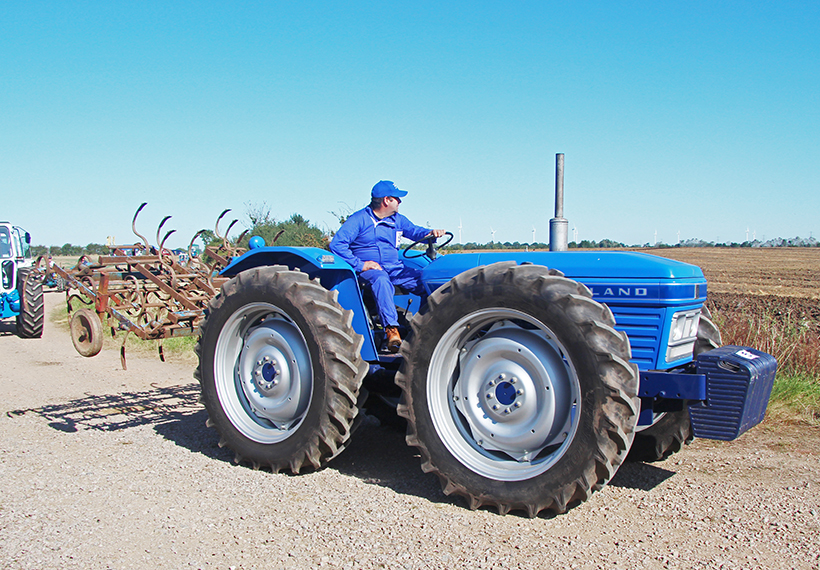
An export version of the 4100, using the same rounded rear mudguards as had been used on the first Leyland tractors of 1969.
The transmission had initially been developed for use with 60hp tractors and although it easily coped with upwards of 70hp, 100hp six-cylinder machines were never in the original design brief. To be fair, the transmission itself faired pretty well with the extra power, but no money or time had been taken to develop a proper connection between the new bigger engines and the gearbox itself. If money had been spent in this area it might have been a very different story when it came to the success of the Leyland heavyweight range.
As it was, news of the problems encountered by customers had a very adverse effect on sales of the six-cylinder models and as the 1970s was a decade when Leyland was dealing with many problems, especially in its many car factories that absorbed money like a sponge, the funds allocated to tractor construction were never enough to correct the error.
Sales of the 485 and 4100 were particularly disappointing, although their higher initial cost and the fact that machines of this output were something of a niche market at that time, probably had as much to do with their lacklustre sales performance as the engine/gearbox issues.
The result was that a few years on and the 485 and the 4100 were dropped from price lists, although the 285 and 2100 would remain and eventually have the alignment problem addressed with the introduction of the synchromesh transmission by the time they were phased out at the end of the decade.
Development
The 255 became the 262 and the 270 the 272 in 1976, with slight increases in power. A quiet cab was introduced the same year to meet new, lower sound level regulations within tractor cabs. The new cab, built for Leyland by Victor Cabs based in the West Midlands, was also fitted to the 245 and the six-cylinder tractors, including the 485 and 4100 during their final throes.

The 2100 was the largest two-wheel drive tractor in the Leyland range, with 100hp on tap from the 6/98 engine.
Leyland tractors were built between 1969 and 1982, but no launch of new models ever came close to the launches of 1972. Despite all the glamour of the six-cylinder models and four-wheel drive County style, the most lasting legacy of that year was without doubt the introduction of the 4/98 engine used in the 255 and 270. That engine would go on to be used in Leyland tractors up to 1982, and then in Marshall tractors after that.
In 1979 the Leyland 282 and 482 saw a turbocharger fitted to the 4/98 engine to boost output to 82 horsepower and then the following year the range received a significant makeover and emerged as the new yellow Harvest Gold range, the models remaining much as before, but now with the option of a new Explorer cab. The 4/98 engine was still used in the 602 and 604, 702 and 704 and the 802 and 804 models.
After Charles Nickerson bought Leyland Tractors and moved production to Lincolnshire under the Marshall name in 1982, Leyland 4/98 engines continued to be used with even a 92hp version being produced as the Marshall 904XL. From 1984 Marshall also used the 6/98 engine to power its brand-new, six-cylinder line of 100 Series tractors – finally producing the sort of heavyweight tractor that deserved to be much more successful than it ultimately became.
50 years ago, British Leyland decided to upgrade its three-model tractor range to encompass no less than eight models. It was a brave move given how tight company finances were at the time and also showed that British Leyland was serious about its position in the world tractor market.

This drawing, used by Leyland in promotional material, shows how the County four-wheel drive system worked on the 485 and 4100 models.
This proved to work, more or less, and certainly there is no doubt that the tractors introduced in 1972 formed an intrinsic part of the future of the Leyland brand at a time when it was thought it would have a much longer and much brighter one than that which later developed. Sadly, the Leyland name itself is now history, and its tractors relegated to the past, something that would have been unthinkable back in 1972.
| Basic specifications: Leyland range (1972) | ||||||||
| Light-weight | Middleweight | Heavyweight | ||||||
| Model | 154 | 245 | 255 | 270 | 285 | 485 | 2100 | 4100 |
| Engine | BMC 15T | Perkins D3.152 | Leyland 4/98DT | Leyland 4/98NT | Leyland 6/98DT | Leyland 6/98NT | ||
| Power | 25hp | 45hp | 55hp | 70hp | 85hp | 100hp | ||
| Cylinders | 4 | 3 | 4 | 6 | ||||
| Capacity | 1.5-litre | 2.5-litre | 3.77-litre | 5.65-litre | ||||
| Transmission | 9 fwd, 3 rev | 10 fwd, 2 rev | ||||||
| Weight | TBC | 2,667kg | 2,857kg | 2,859kg | 3,628kg | TBC | 3,628kg | TBC |
Useful contacts
John Charnley & Sons
Brindle, Lancashire
01254 854103
charnleys.com
Tractor Spare Parts Ltd
Alstonefield, Derbyshire
Tel: 01335 310538
tractorspareparts.co.uk
For a money-saving subscription to Tractor & Machinery magazine, simply click HERE



